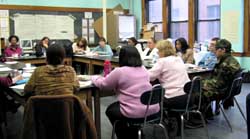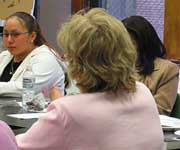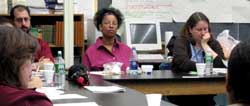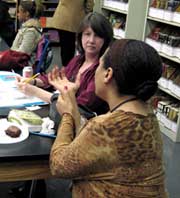|
|
|
“Education is not the filling of a pail, but the lighting of a fire.” — William Butler Yeats
“In one of my classes—a class where we all just get along—we've been discussing the book, Two Kinds, by Amy Tan. It's about the struggles between a mother and daughter. Today, we had this amazingly candid discussion about kids and their parents and the dynamics of those relationships.” — Susan Friendson, 12th grade English teacher
Louise Wynkoop (9th grade literacy): We've been doing a project that's really brought the class to life. We read the novel The Color of My Words, which celebrates growing up in the Dominican Republic, and we decided to orchestrate a “fiesta” day. Students wrote down the recipes for their favorite foods—most of the students are Hispanic or Asian—and we created our own cookbook from them. They also wrote a short skit based on a favorite scene or event in the novel. Then, today, “fiesta day” students made their favorite food and brought them to class and acted out their skits in front of the class. They'd decorated the room.
The students cooperated and rallied together like I've never seen them before—there was teamwork. So The Color of My Words ended up being, for us, The Color of Our Lives. There was such a community feeling. [ For a copy of the cookbook, in PDF form, click here ]
Susan Friendson (12th grade English): In one of my classes-a class where we all just get along— we've been discussing the book, Two Kinds, by Amy Tan.
Susan Dillon (11th grade English): A time that learning came especially alive for me was when students in one of my senior classes chose the novel they were reading—as opposed to having it chosen for them. They worked in small groups and had ten books to choose from. They also decided how they would present the book they chose to read to the rest of the class—they could do a skit, a panel discussion, whatever they wanted. The presentations were among the most exciting we've ever had. Kids spoke who had hardly spoken before, and they had such poise.
One of the best presentations was from a group that had read a book geared for adults called The Reader. It deals with a relationship between a 35-year-old woman and a 15-year-old boy. They felt, I think, empowered by reading something that was written about a very sensitive subject, a mature subject, and for adults. It made them feel adult.
Don Cala (Biology): In my biology class, I try to bring into the classroom a lot of everyday objects as examples. Most students don't realize that science is all around them, that their lives are filled with science. I look for objects they can relate to.
Sharyn Fuller (English, Art, Study Skills): When we read The Crucible in my class, we reenacted the trial from the story. I took the students into [Central's] courtroom for the final presentation. Each student had a part, or several parts, according to what they felt comfortable with. Some created their own costumes. The quietest students took the part of a jury member. One of the most outgoing students played the judge. She was awesome-and had no problem batting her eyelashes and telling some of the students [when they weren't staying in character] “Out of my courtroom!” The students really liked being in the courtroom—they took it seriously. When we went back to our classroom after that, they maintained that seriousness. Students still say it was one of the most fun things they did.
Shai Afsai (9th grade English): For me, one thing that's made a big difference, and not just for one day or one week but long term, are the small libraries we now have in each classroom—and the idea of letting students choose from them. Students can pick the books they want to read. In my class, we also came up with a list of ways that students can share those reading experiences. They don't necessarily have to share it with someone else. If they want, they can create a piece of art or a private written reflection. Just giving them the freedom to pick something to read and then to decide how to present that book—whether they do it in a conversation with another student or in a more private way—has worked so well.
Bianca Gray (school redesign coach): So what I'm certainly hearing is the importance of relevance and choice in sparking students' interests.
Susan Friendson: That's right. I think one of the hardest things about teaching is getting kids to work on things that they don't think are relevant to their own lives, things that don't have any real connection to them—and where they have no input. For a lot these kids, they might actually choose something like Shakespeare to read if they wanted to, but the point is that they don't have a choice. And we have no choice. It doesn't matter so much what has been chosen, but the fact that it was chosen for them.
Susan Dillon: You know, when we read Shakespeare plays in class, the kids will often ask, “Why can't I read another playwright? Why is Shakespeare the only playwright I know?” They don't know that there are playwrights that are still alive—or playwrights who aren't white and male. They don't know that there are African—American playwrights and women playwrights—playwrights that might even make them love theatre.
Central High School | 70 Fricker St., Providence, RI 02903 | 401.456.9111
Copyright © 2005 |


 This March and April, What Kids Can Do sat in on an after school book club of Central High School faculty and students. Each week the club's sixteen members meet for an hour and a half to share their love for reading. One afternoon we talked to them about what makes learning come alive in their classes and asked them to describe a time when their classroom pulsed with energy. Here's what they had to say.
This March and April, What Kids Can Do sat in on an after school book club of Central High School faculty and students. Each week the club's sixteen members meet for an hour and a half to share their love for reading. One afternoon we talked to them about what makes learning come alive in their classes and asked them to describe a time when their classroom pulsed with energy. Here's what they had to say.
 It's about the struggles between a mother and daughter, and we were examining the climax. Today, we had this amazingly candid and interesting discussion about kids and their parents and the dynamics of those relationships. And it wasn't the first time this has happened. I think about it all the time, why the discussions in this particular class are so rich. I think it's because we all trust each other.
It's about the struggles between a mother and daughter, and we were examining the climax. Today, we had this amazingly candid and interesting discussion about kids and their parents and the dynamics of those relationships. And it wasn't the first time this has happened. I think about it all the time, why the discussions in this particular class are so rich. I think it's because we all trust each other.
 Well, today I brought a radio into class and started flipping through stations and then stopped the dial in between stations—those spots where you hear all of the white noise. I asked them, “Where does that static, that 'white noise,' comes from?” No one knew. So I told them that it was noise [“cosmic microwave background radiation”] left over from the Big Bang. They were like, “Oh—wow! residual radiation!” So we talked about the Big Bang for a while, about how light from 14 billion light-years away is still reaching us today, about receding galaxies, and things like that. I think they got a lot out of it.
Well, today I brought a radio into class and started flipping through stations and then stopped the dial in between stations—those spots where you hear all of the white noise. I asked them, “Where does that static, that 'white noise,' comes from?” No one knew. So I told them that it was noise [“cosmic microwave background radiation”] left over from the Big Bang. They were like, “Oh—wow! residual radiation!” So we talked about the Big Bang for a while, about how light from 14 billion light-years away is still reaching us today, about receding galaxies, and things like that. I think they got a lot out of it.
 Liz Vazquez (English as a Second Language, Literacy): I work with intermediate ESL kids, and a lot of times I think it's the content that slows down their learning. Like Louise, we also read The Color of My Words, and I was simply amazed by what the students picked up and wrote about, how they remembered everything and understood so much. Almost all of the kids in my class are Dominican, and the story is set in the Dominican Republic. So they were able to identify closely with the characters, to really grasp the concept of family. They became the experts because they were the experts. It got to the point where they were teaching me about their culture. I was so proud of them and the way they got to shine.
Liz Vazquez (English as a Second Language, Literacy): I work with intermediate ESL kids, and a lot of times I think it's the content that slows down their learning. Like Louise, we also read The Color of My Words, and I was simply amazed by what the students picked up and wrote about, how they remembered everything and understood so much. Almost all of the kids in my class are Dominican, and the story is set in the Dominican Republic. So they were able to identify closely with the characters, to really grasp the concept of family. They became the experts because they were the experts. It got to the point where they were teaching me about their culture. I was so proud of them and the way they got to shine.